
Orange is a city in the Central Tablelands region of New South Wales, Australia. It is 254 km (158 mi) west of the state capital, Sydney [206 km (128 mi) on a great circle], at an altitude of 862 metres (2,828 ft). Orange had an urban population of 41,920 at the 2021 Census, making the city a significant regional centre. A significant nearby landmark is Mount Canobolas with a peak elevation of 1,395 m (4,577 ft) AHD and commanding views of the district. Orange is situated within the traditional lands of the Wiradjuri tribe.

Walka Water Works is a heritage-listed 19th-century pumping station at 55 Scobies Lane, Oakhampton Heights, City of Maitland, New South Wales, Australia. Originally built in 1887 to supply water to Newcastle and the lower Hunter Valley, it has since been restored and preserved and is part of Maitland City Council's Walka Recreation and Wildlife Reserve. It was added to the New South Wales State Heritage Register on 2 April 1999.

Alexandra Mine and Battery is a heritage-listed mine at Palmerville Station, Maytown, Shire of Cook, Queensland, Australia. It was built from c. 1878 to 1898. It is also known as Alexandra PC.It was added to the Queensland Heritage Register on 21 October 1992.

Great Northern Mine is a heritage-listed mine off Jacks Road, Herberton, Tablelands Region, Queensland, Australia. It was built from 1880 to 1940s. It was added to the Queensland Heritage Register on 21 October 1992.

Coolgarra Battery is a heritage-listed stamper battery at Coolgarra Station, Silver Valley, Tablelands Region, Queensland, Australia. It was built from 1896 to 1901. It is also known as Coolgarra Old Furnace. It was added to the Queensland Heritage Register on 25 August 2000.

Rocky Bluff Battery and Township is a heritage-listed former mining town at Watsonville, Shire of Mareeba, Queensland, Australia. It was built from 1902 to c. 1926. It is also known as Stannary Hills Mill. It was added to the Queensland Heritage Register on 13 December 2002.

Vulcan Mine is a heritage-listed former mine at Mareeba Mining District, Irvinebank, Shire of Mareeba, Queensland, Australia. It was built from c. 1889 to 1930s. It was added to the Queensland Heritage Register on 21 October 1992.

Kingsborough Battery is a heritage-listed mining building off the former East Street, Kingsborough, Thornborough, Shire of Mareeba, Queensland, Australia. It was built from c. 1896 to 1990s. It was added to the Queensland Heritage Register on 21 October 1992.

Tyrconnel Mine and Battery is a heritage-listed gold mine between Kingsborough and Thornborough, Shire of Mareeba, Queensland, Australia. It was built from 1876 to 1980s. It was added to the Queensland Heritage Register on 21 October 1992.

Mabel Mill is a heritage-listed former stamper battery at Barton Street, Ravenswood, Charters Towers Region, Queensland, Australia. It was built from c. 1871 to c. 1902. It is also known as Mabel Mill and Partridge Mill. It was added to the Queensland Heritage Register on 28 January 1994.
Joseph Morris Mine is a heritage-listed former mine at Georgetown Mining District, Gilberton, Shire of Etheridge, Queensland, Australia. It was built from 1903 to 1910. It was added to the Queensland Heritage Register on 5 April 2004.

Richmond Mine and Battery is a heritage-listed mine at Gulf Developmental Road, Croydon, Shire of Croydon, Queensland, Australia. It operated from 1886 to c. 1916. It was added to the Queensland Heritage Register on 28 July 2006.
Cadia is a locality in the Cabonne Council of New South Wales, Australia. It was formerly a private township established c. 1860s by the Cadiangullong Consolidated Copper company. It is now part of the Cadia-Ridgeway Mine lease, operated by Newcrest. It had a population of zero as of the 2016 census.

Sewage Pumping Station 38 is a heritage-listed sewerage pumping station located on General Holmes Drive, in the Sydney suburb of Mascot, in the Bayside Council local government area of New South Wales, Australia. It was designed and built by the Metropolitan Water Sewerage and Drainage Board. It is also known as SPS 38, Mascot Sewage Pumping Station and SP0038. The pumping station is owned by Sydney Water, an agency of the Government of New South Wales. It was added to the New South Wales State Heritage Register on 18 November 1999.

Day Dream Smelter is a heritage-listed former smelter and now archaeological site located on an unnamed road at Broken Hill, New South Wales, Australia, approximately 20 km north-west of Broken Hill town. The property is owned by the Broken Hill City Council. It was added to the New South Wales State Heritage Register on 2 April 1999.

Goulburn Pumping Station is a heritage-listed former municipal water supply system and now museum at Wollondilly River, Goulburn, Goulburn Mulwaree Council, New South Wales, Australia. It was built from 1885 to 1886. It includes the historic Appleby Steam Engine, which is contained in the pumping station.

Quartz Roasting Pits Complex is a heritage-listed quartz roasting kiln located 10km north of Hill End, Mid-Western Regional Council, New South Wales, Australia. It was built from 1854 to 1855. It is also known as Cornish Roasting Pits. The property is owned by the New South Wales Office of Environment and Heritage. It was added to the New South Wales State Heritage Register on 2 April 1999.

The Ryde Pumping Station is a heritage-listed pumping station and offices located at Victoria Road, West Ryde, New South Wales, Australia. It was built from 1891 to 1921 by William Adams & Co. Ltd., State Monier Works, Refshaw & O'Brien. It is also known as Ryde Pumping Station and site, WP005 and West Ryde Pumping Station. The property is owned by Sydney Water. It was added to the New South Wales State Heritage Register on 15 November 2002.

Ottery Mine is a heritage-listed former mine located 8 km north-east of Emmaville, Glen Innes Severn, New South Wales, Australia. It was built from 1882 to 1939. The property is owned by the New South Wales Department of Primary Industries. It was added to the New South Wales State Heritage Register on 2 April 1999.

Sewage Pumping Station 271 is a heritage-listed sewage pumping station located adjacent to 5 Carrington Road, Marrickville, Inner West Council, Sydney, New South Wales, Australia. It was designed and built by the New South Wales Public Works Department. It is also known as SPS 271. The property is owned by Sydney Water. It was added to the New South Wales State Heritage Register on 18 November 1999.



















